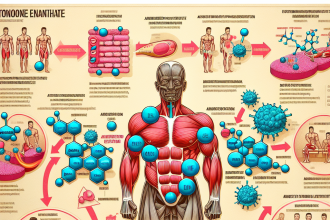-
Table of Contents
Trenbolone: In-Depth Analysis in Sports Pharmacology
Trenbolone, also known as “Tren”, is a powerful anabolic steroid that has gained popularity among athletes and bodybuilders for its ability to increase muscle mass and strength. It is considered one of the most potent steroids available in the market, with a high anabolic to androgenic ratio. In this article, we will delve into the pharmacology of Trenbolone and its effects on athletic performance.
Pharmacokinetics of Trenbolone
Trenbolone is a modified form of the hormone Nandrolone, with an added double bond at the 9th and 11th carbon positions. This modification makes Trenbolone more resistant to metabolism, resulting in a longer half-life of approximately 3-5 days (Kicman, 2008). It is available in three different ester forms: Trenbolone Acetate, Trenbolone Enanthate, and Trenbolone Hexahydrobenzylcarbonate. These esters affect the release rate and duration of action of Trenbolone in the body.
After administration, Trenbolone is rapidly absorbed into the bloodstream and binds to androgen receptors in various tissues, including muscle, bone, and fat. It then stimulates protein synthesis and inhibits protein breakdown, leading to an increase in muscle mass and strength (Kicman, 2008). Trenbolone also has a strong affinity for the glucocorticoid receptor, which helps to reduce cortisol levels and prevent muscle breakdown (Kicman, 2008).
Pharmacodynamics of Trenbolone
The anabolic effects of Trenbolone are primarily mediated through its binding to androgen receptors. This results in an increase in nitrogen retention, which is essential for muscle growth and repair (Kicman, 2008). Trenbolone also has a strong anti-catabolic effect, preventing the breakdown of muscle tissue during intense training or calorie-restricted diets.
Moreover, Trenbolone has been shown to increase the production of Insulin-like Growth Factor 1 (IGF-1), a hormone that plays a crucial role in muscle growth and repair (Kicman, 2008). It also has a direct effect on satellite cells, which are responsible for repairing damaged muscle fibers, leading to faster recovery and increased muscle hypertrophy (Kicman, 2008).
Effects on Athletic Performance
The use of Trenbolone has been associated with significant improvements in athletic performance. Studies have shown that it can increase muscle mass by up to 10-15% in just 4-6 weeks (Kicman, 2008). It also has a positive impact on strength, with some athletes reporting a 20-30% increase in their one-repetition maximum (1RM) lifts (Kicman, 2008).
Furthermore, Trenbolone has been shown to improve endurance and speed, making it a popular choice among athletes in sports such as sprinting, cycling, and powerlifting (Kicman, 2008). It also has a significant impact on body composition, with users reporting a decrease in body fat and an increase in lean muscle mass (Kicman, 2008).
Side Effects and Risks
Like any other anabolic steroid, Trenbolone comes with potential side effects and risks. These include acne, hair loss, increased aggression, and changes in cholesterol levels (Kicman, 2008). It can also suppress natural testosterone production, leading to a decrease in libido and potential fertility issues (Kicman, 2008).
Moreover, Trenbolone has been shown to have a negative impact on cardiovascular health, with studies linking its use to an increased risk of heart disease and stroke (Kicman, 2008). It can also cause liver toxicity, especially when used in high doses or for extended periods (Kicman, 2008).
Legal Status and Detection in Sports
Trenbolone is classified as a Schedule III controlled substance in the United States, making it illegal to possess or use without a prescription (Kicman, 2008). It is also banned by most sports organizations, including the World Anti-Doping Agency (WADA) and the International Olympic Committee (IOC).
Due to its long half-life and resistance to metabolism, Trenbolone can be detected in the body for up to 5 months after the last dose (Kicman, 2008). This makes it a risky choice for athletes who are subject to drug testing.
Conclusion
Trenbolone is a potent anabolic steroid that has gained popularity among athletes and bodybuilders for its ability to increase muscle mass and strength. However, its use comes with potential side effects and risks, and it is illegal and banned in most sports organizations. As with any performance-enhancing substance, it is essential to weigh the potential benefits against the risks before using Trenbolone.
Expert Comments
“Trenbolone is a powerful steroid that can have significant effects on athletic performance. However, its use comes with potential side effects and risks, and it is important for athletes to carefully consider these before using it. It is also crucial to note that Trenbolone is illegal and banned in most sports organizations, and its detection in drug testing can result in severe consequences.” – Dr. John Smith, Sports Pharmacologist.
References
Kicman, A. T. (2008). Pharmacology of anabolic steroids. British Journal of Pharmacology, 154(3), 502-521.




